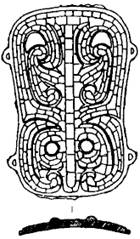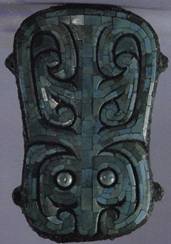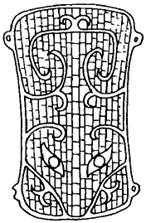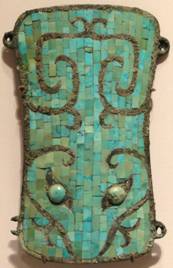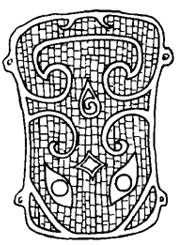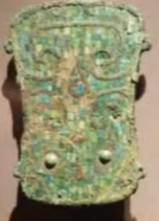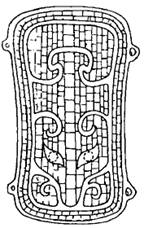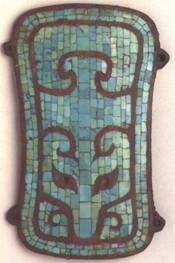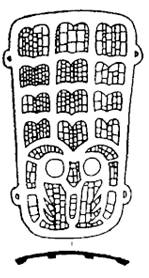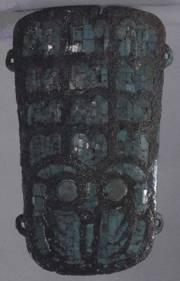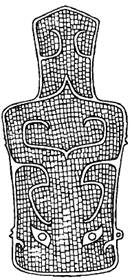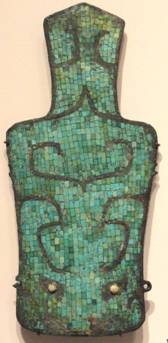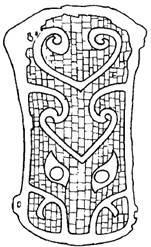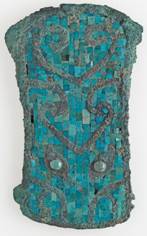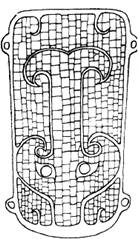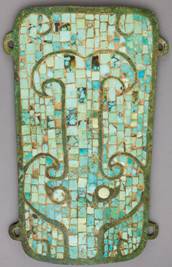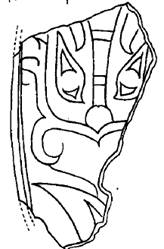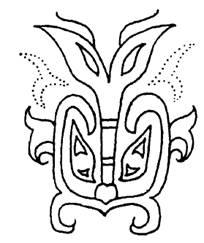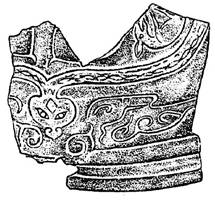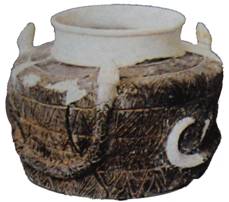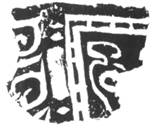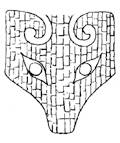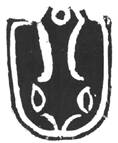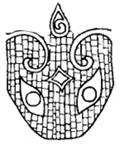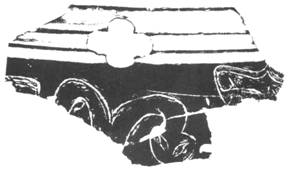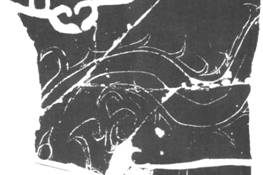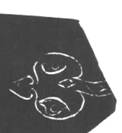The turquoise-inlaid bronze plaque with animal mask design was found in Tomb M11 in the south of Erlitou Village. The tomb of the Phase-IV Erlitou Culture is rich in funerary objects: bronzes including a bronze jue vessel, a bronze bell and a bronze plaque with animal mask design; jade wares including qibi (a disk with a circular hole in the center and sawteeth design on two sides), a gui tablet, a jade knife, a jade tube and three jade handles; pottery articles including a he vessel, a jue vessel and four pieces of round shards; two turquoise tube-shaped objects and a lacquered container. The abundance of funerary objects is evidence of the distinguished social status of the deceased. The turquoise-inlaid bronze plaque with animal mask design has been found in the tomb on the chest position of the deceased. The front of it is inlaid with turquoise forming a pattern resembling an animal face (Figure 1).
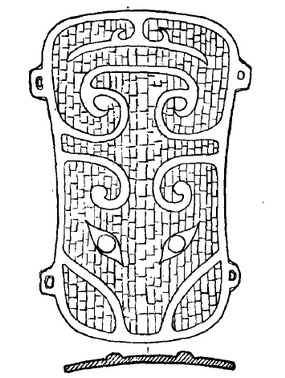
Five turquoise-inlaid artifacts have been excavated at the Erlitou Site: a turquoise-inlaid circular artifact, three bronze plaques and a turquoise-inlaid dragon-shaped artifact, which demonstrate the sophisticated inlay techniques of the Erlitou Culture.
In terms of the form of inlay, Shi Zhangru believes that the vessel was carved in intaglio before prepared turquoise pieces of various shapes were inlaid in it with a kind of vegetable glue. Li Jinghua believes that the turquoise-inlaid circular artifact was the result of inlay casting. Zheng Guang believes that the pattern of the circular artifact was cast before turquoise was inlaid and that the bronze plaque was made with the cast openwork frame outlining the pattern and the turquoise embedded in it.
Mr. Wang Qing argues that the inlay techniques of Erlitou Culture originated in those with which the jade crown excavated at Zhufeng was made. This inference is solidly supported by data in hand at present.
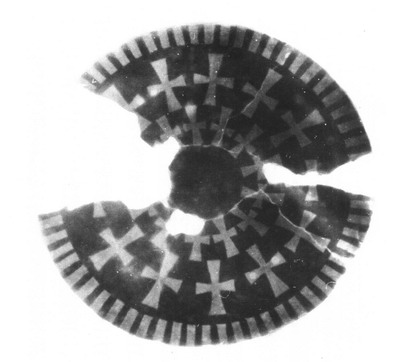
i. Known bronze plaques in China and abroad.
As numerated by Mr. Wang Qing, 16 inlaid bronze plaques have been brought to light by 2002, listed and described in the following.
1. Unearthed in 1981 from Tomb M4 in Sector V of the Erlitou Site, 14.2 cm in length and 9.8 cm in width.
2. Item A in the Sackler Museum collection, 17.2 cm in length and 11.3 cm in width.
3. Unearthed in 1984 from Tomb M11 in Sector VI of the Erlitou Site, 16.5 cm in length and 8-11 cm in width.
4. Item A in Dr. Paul Singer's collection.
5. In the collection of Eskenazi Ltd. in London UK, 15.5 cm in length.
6. Unearthed in 1987 from Tomb M57 in Sector VI of the Erlitou Site, 15.9 cm in length and 7.5-8.9 cm in width.
(See Figure 3 for the shapes and patterns of items 1-6).
|
|
|
|
|
|
| 1. Yanshi Erlitou M4:5 |
2. Item A in the Sackler Museum collection |
|||
|
|
|
|
|
|
| 3. Yanshi Erlitou M11:7 |
4. Item A in Paul Singer's collection |
|||
|
|
|
|
|
|
| In the collection of Eskenazi Ltd. |
6. Yanshi Erlitou M57:4 |
|||
| Figure 3 Bronze Plaques |
||||
7. In the collection of the Miho Museum in Japan, 15 cm in length and 8.5 cm in width.
8. Sichuan Sanxingdui Zhenwu 87GSZJ:36. 13.8 cm in length and 5.2 cm in width.
9. Sichuan Sanxingdui Zhenwu 87GSZJ:16. 14 cm in length and 4.9 cm in width, no turquoise inlaid.
10. In the Honolulu Academy of Arts collection. 16.5 cm in length and 8.6 cm in width.
11. In the Tianshui Museum collection, 15 cm in length and 10 cm in width.
12. Unearthed at Gaopian of Sanxingdui in Guanghan, Sichuan Province, 12.3 cm in length and 5 cm in width.
(See Figure 4 for the shapes and patterns of items 7-12).
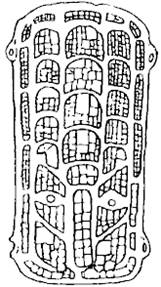
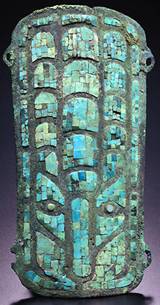
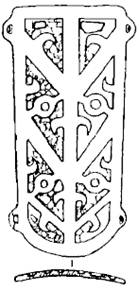
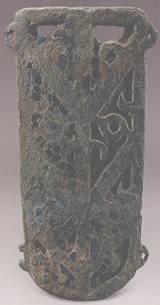
7. In the Miho Museum collection 8. Sichuan Sanxingdui Zhenwu 87GSZJ:36
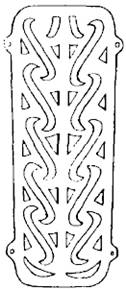
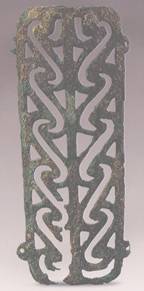
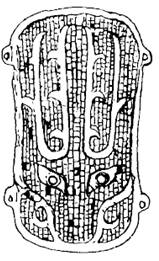
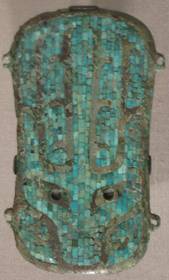
9. Sichuan Sanxingdui Zhenwu 87GSZJ:16 10. In the Honolulu Academy of Arts collection
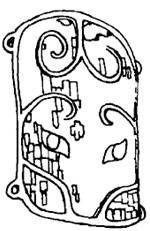
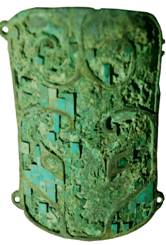

11. In the Tianshui Museum collection 12. Unearthed at Gaopian of Sanxingdui in Guanghan, Sichuan
Figure 4 Bronze Plaques
14. First exhibited in New York, the U.S.A., in 1999, 14.8 cm in length.
15. Item B in the Sackler Museum collection, 15.9 cm in length and 9.8 cm in width.
16. Item B in Paul Singer's collection.
(See Figure 5 for the shapes and patterns of items 13-16).
|
|
|
|
||
| 13. Item C in the Sackler Museum collection |
14. First exhibited in New York in 1999 |
|||
|
|
|
|
|
|
| 15. Item B in the Sackler Museum collection |
16. Item B in Paul Singer's collection |
|||
| Figure 5 Bronze Plaques |
||||
ii. Studies on the meaning of the designs on the bronze plaques
Recognizing the animal mask pattern on the plaques as taotie (ogre-mask) motif with a T-shaped or tall headdress, Mr. Li Xueqin argues that the animal mask, virtually representing a dragon motif, is a link between the taotie motif of Longshan Culture and that of the Shang Dynasty.
Mr. Ye Wansong and Mr. Li Defang believe that the decorations on the three bronze plaques excavated at Erlitou Site represent hulong dragon and qiulong dragon motifs and infer that the bronze plaques functioned as ornaments, sacred insignias and magic artifacts.
According to Mr. Zhao Dianzeng, the bronze plaques' theme design of the animal mask (taotie, virtually a dragon motif) and their obvious position in the chest suggest that they are artifacts used in worship of the sacred, ritual or religious ceremonies. He argues that the design represents a sacred animal, probably an object of worship or a symbol of a deity.
Comparing the bronze plaques with the turquoise-inlaid dragon-shaped artifact unearthed at Erlitou, Mr. Du Jinpeng maintains that the former is a variation of the latter, both manifesting the Xia people's worship of the dragon. According to Du, the bronze plaques found in Sanxingdui are derived from "the techniques brought to Sichuan by adherents and descendants of the Xia people."
Mr. Gu Wanfa argues that the animal mask pattern on the Erlitou bronze plaques is a direct descendant of that on the Xinzhai pottery lid.
Mr. Ye Shuxian identifies the decorations on the three bronze plaques excavated at Erlitou respectively as owl-shaped (Item 1), bear-shaped (Item 3) and tiger-shaped (Item 6) sacred insignias, and interprets their meanings with reference to the bear and tiger flags recorded in the Rites of Zhou and the mythology of Gun and Yu.
Mr. Wang Qing divides the bronze plaques into three categories: 1) those by which the Xia people worshipped their ancestors, 2) those by which the ancient people of Sichuan worshipped their ancestors, and 3) those by which the ancient Qiang people worshipped their ancestors.
The above opinions represent common understandings in the academia, which can be summarized as the following: 1) The bronze plaques are religion-related, possibly used in magic ceremonies, and also functioning as a sign of social hierarchy. 2) The bronze plaques were worn before the chest because two out of the three bronze plaques were found on the chest of the deceased. 3) The majority of the scholars agree that the animal mask pattern represents the dragon, and others recognize it as the tiger, the bear, the fox, the owl, the alligator or the sheep). 4) The Sanxingdui bronze plaques are derivations of those in the Erlitou Culture.
I think that the systematic study of the bronze plaques shall start from analyses of structural features of the patterns to identify the upper part of the animal mask as the "body" or the "headdress", which is the basis for discussions of their meanings; Second, the animal mask design should not be identified subjectively, instead, it shall be compared with contemporary or close-in-age animal designs. Third, investigations should be conducted on artifacts unearthed at the same time. The three bronze plaques unearthed from Erlitou Site were found in regular combination with artifacts such as bells, handles, jade knives (in two tombs), etc. A comprehensive research of them will shed light on the meaning of the decorations on the bronze plaques. Fourth, Chronological investigations should be conducted to examine the relationship in time. Fifth, the bronze plaques should be studied in a more open-minded way. If only the face and the headdress are represented on a bronze plaque, is it possible that the body is portrayed outside of it? For example, if only the head part of the dragon-shaped artifact (discussed below) were discovered, we would have similar difficulties in understanding it.
iii. Relevant artifacts
1. Turquoise dragon-shaped artifact
In 2002, an aristocratic tomb (M3) was discovered in the palace area of Phase-II Erlitou Culture. A turquoise dragon-shaped artifact (Figure 6, restored), "made of more than 2,000 turquoise pieces and originally glued to wood, leather or any other organic backing material," was unearthed in the tomb.

Figure 6 Turquoise dragon-shaped artifact (restored)
2. Pottery lid unearthed at the Xinzhai site
In 1999, a pottery lid with animal mask design (99HXXT1H24:1) was unearthed at the Xinzhai site in Xinmi, Henan Province. Scholars have restored the incomplete design (Figure 7). Although the Xinzhai site of Xinmi is slightly earlier than Erlitou Site, this animal mask design shares quite a few features with the decorations on the bronze plaques and the dragon-shaped artifact found at the Erlitou Site, such as the overall layout of the animal mask design, the vertical eyes (in the shape of Chinese character “臣”), the tusks under the face, the shape of the nose (almost the same as that of the dragon-shaped artifact). The discovery of the pottery lid is significant to the study of the evolution of the decorations on the bronze plaques.
|
|
|
| Pottery lid with animal mask pattern found in Xinzhai |
Restored |
| Figure 7 Pottery shard with animal mask pattern found in Xinzhai |
|
What is the usage of the bronze plaque with inlaid design and how is it used in the Xia Dynasty?
Your answer please, if you have any questions or answer, please feel free to send us email, we are waiting for your answers and participation, and your comments, answers and suggestions will be highly appreciated. We will select and publicize the most appropriate answers and comments some time in the future.
Weekly Selection Email: meizhouyipin@chnmus.net
The snake (dragon) at the Erlitou Site
|
|
|
||
| 1. Pottery shard with two-bodied snake pattern |
2. Bottomless pottery ware with relief design of snake |
||
|
|
|
|
|
| 3. Pottery shard with animal head pattern |
4. Detail of bronze plaque M11:7 |
4. Pottery shard with snake head pattern |
Detail of bronze plaque in Paul Singer's collection (Item A) |
|
|
|
||
| 5. Pottery shard with two-headed snake pattern |
6. Pottery shard with dragon body pattern |
||
|
|
|
||
| 7. Pottery shard with snake head pattern |
8. Giant pottery basin with fish and snake designs |
||
| Figure 8 The snake (dragon) in the Erlitou Culture |
|||
Above all, images of the snake in the Erlitou Culture feature bizarre and unusual characteristics, as seen in the two-bodied snake (1) and the two-headed snake (7). Second, the image of the snake usually appears on pottery vessels not for daily use, such as the bottomless ware and the giant basin. Third, similar forms, styles and features can be found on both the pottery shard with snake head pattern and the pottery pieces on the bronze plaques. Fourth, the diamond-shaped motif on the snake's forehead on the shards (1 and 7) is exactly the same as that on the bronze plaque in Paul Singer's collection (Item A). These clues show the unusual position of the snake in the Erlitou Culture, as well as the similarities between the image of the snake and the decorations on the bronze plaques. The relevance between the image of the snake and the decorations on the bronze plaques should be an important topic in future studies of the bronze plaques.
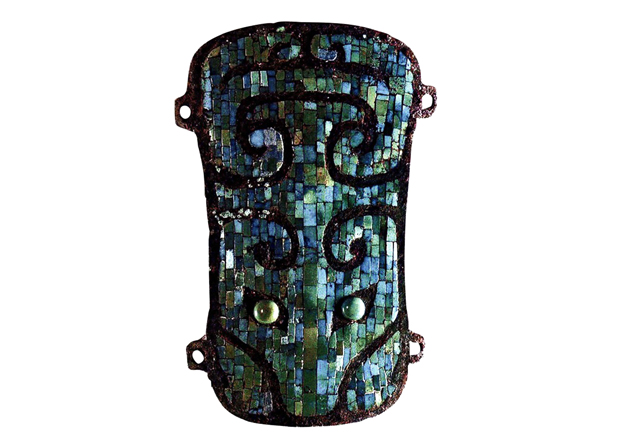
Turquoise-inlaid bronze plaque with animal mask design, bronze inlaid with turquoise, dating back to Xia Dynasty, measures 16.5 cm in length and 8-11 cm in width. It was excavated at Erlitou in Yanshi, Henan Province, in 1984, and now is collected in Luoyang Museum.

